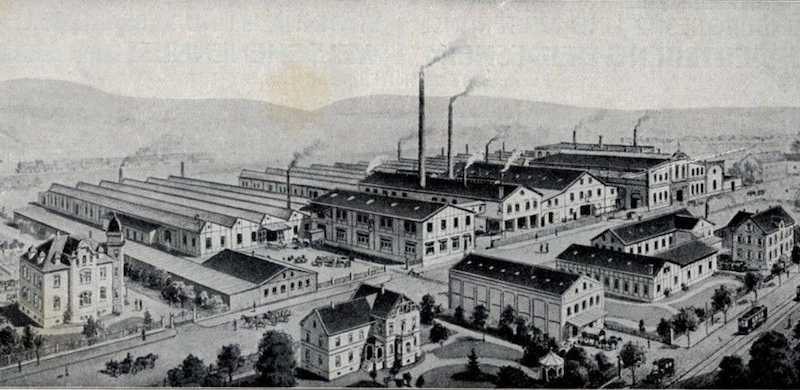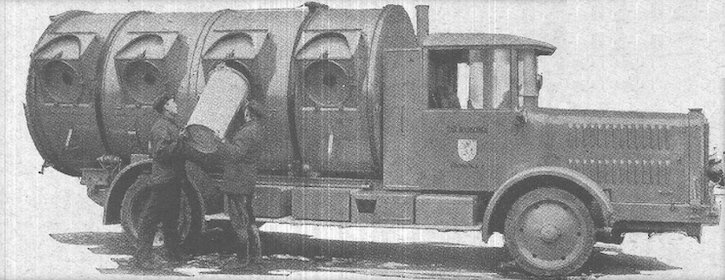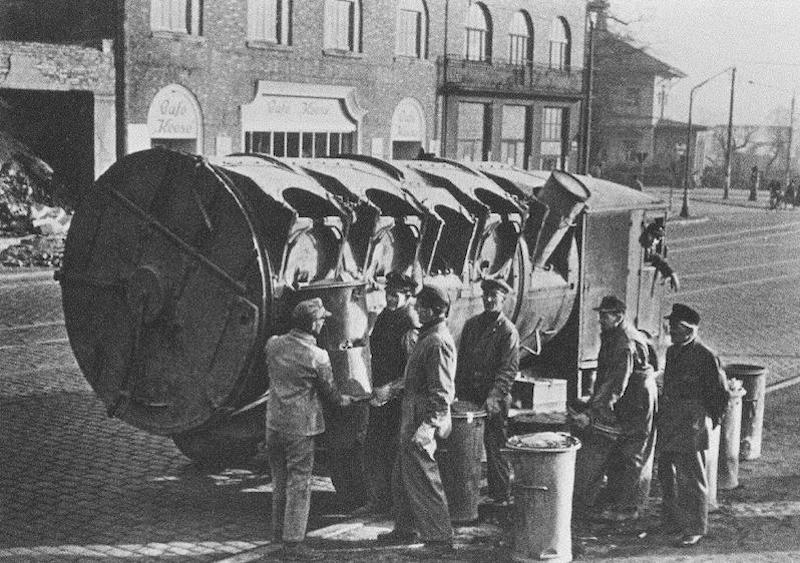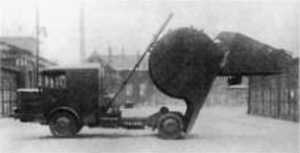 
Schmidt & Melmer
Weidenau, Germany

This company was founded in 1870, and was a major rolled steel producer in Germany. A successful line of fireproof steel ash barrels was developed, which were later modified for use in dustless sanitary refuse collection. In addition to the barrels, Schmidt & Melmer patented a self-sealing "dustless shutter system", which eliminated the escape of dust during refuse collection. Each household was issued a round refuse container by their city, which mated with special shutter attached to the collection vehicle. The containers were hand fitted to the shutter device, and manually tipped to empty their contents. As they were tipped, the hinged lid on the bin opened to allow the contents out, all the while being completely sealed against the escape of any dust. The 1920s and 1930s saw dustless collection being widely adopted in Germany, and the Schmidt & Melmer system was the most popular during these years.

An early Schmidt & Melmer side & aft tipper mounted on a FAUN chassis
Dustless shutters could be adapted to fit various collection bodies, including horse-drawn types. In 1925, Heinrich Neuy of Hamburg patented a unique side & aft tipper refuse body, which was built by Schmidt & Melmer. It consisted of a circular body fitted with a row of four or five Schmidt & Melmer dustless shutters on the street side. The containers were attached and manually emptied into the body, which was periodically rolled sideways to consolidate the load within. The rolling action consolidated the load, and made room for subsequent collections. Discharge of the load was by tipping, out of a rear-hinged tailgate. This system used extensively by Hamburg and other cities, and in 1928 was licensed to Eagle Engineering for manufacture in England.
Karl Schmidt patented a rear-loading, fore & aft tipper in 1927, of which a few are believed to have been built. Following the Second World war, production of dustless bin systems resumed for a few years, but changing practices in refuse collection led to a downturn in business, and the company ceased operations in 1959. Upon expiration of the patents, much of their business was eventually taken over by Otto, whose founder had started with Schmidt & Melmer in the 1920s.
Special thanks to Sjef van Lierop, Alex Penner and the City of Hamburg
Fortunately, there exists an excellent demonstration film from 1928, which shows the vehicle in action, complete with animated sequences illustrating how the load behaves inside the drum. This film has the distinction of being the earliest known film of a mechanized refuse truck in existence. Watching the crews collect in a densely-populated urban area, it becomes clear why so much effort went into dust control. It is also a fascinating look at the daily routine of refuse crews of pre-war Germany.
Click here to watch the video on YouTube.com
|

The Hamburg fleet in Germany, 1943, just prior to its destruction.
In late July of that year, an allied bombing raid caused a firestorm which destroyed the city, killing over 42,000 people

One of the few Hamburg trucks which survived the war was still in use in 1948

This truck may be a Schmidt & Melmer fore & aft tipper
REFERENCES
The Commercial Motor: 2 February 1928, pages 54-55 Refuse Collection on the Continent
The Commercial Motor: 5 June 1928, page 46 Wheels of Industry
The Business of Waste: Great Britain and Germany, 1945 to the present
(2013, by Raymond G. Stokes, Roman Koster and Stephan C. Sambrook)
|
SELECTED PATENTS
|
Patent # |
Description |
Inventor |
Assignee |
Date |
|
US1715364 |
Device for the dust-free discharge of circular dustbins into... |
Hirschner |
Schmidt & Melmer |
December 17, 1925 |
|
US1686167 |
Vehicle for receiving and transporting refuse and the like |
Neuy |
|
November 10, 1925 |
|
US1781346 |
Dust Cart |
Schmidt |
|
November 8, 1927 |

9/25/16
© 2016
All Rights Reserved
Logos shown are the trademarks of respective manufacturers
Photos from factory brochures/trade advertisements except as noted
|
|
| |